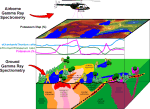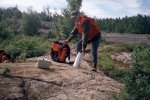Proactive disclosure
Print version   |  | 
Natural Resources Canada > Earth Sciences Sector > Priorities > Strong and safe communities > Radiation Geophysics
Radiation Geophysics Gamma-ray spectrometry surveys
Gamma-ray spectrometry can be conducted in the air or on the ground. In the air,
it provides cost-effective, systematic coverage of large areas and is easily combined
with traditional aeromagnetic and electromagnetic sensors, in a single, multisensor survey.
On the ground, in-situ spectrometry provides quantitative, real-time results, which
may distinguish geological units and alteration associated with mineralizing systems.
 Alteration associated with mineralization can be distinguished from barren rocks
using gamma-ray spectrometry. In this illustration, the potassium (K) map (just one
of 14 variables obtained from the airborne survey) exhibits elevated K values
associated with alteration in a large porphyry (Cu-Au +/-Mo) system on the
left and in a second area on the right, a barren felsic intrusion.
Alteration associated with mineralization can be distinguished from barren rocks
using gamma-ray spectrometry. In this illustration, the potassium (K) map (just one
of 14 variables obtained from the airborne survey) exhibits elevated K values
associated with alteration in a large porphyry (Cu-Au +/-Mo) system on the
left and in a second area on the right, a barren felsic intrusion.
So, can we distinguish the important K from the less interesting K? Yes!
The vein and porphyry-hosted mineralization is fingerprinted by the
characteristic low eTh/K ratio (green profile), which appears in both the airborne
survey data and subsequent ground survey data. Conversely, the eU/eTh values
(blue profile) are elevated only over the felsic intrusion.
Although it is desirable to attempt to obtain as much useful information
as possible from a airborne geophysical surveys, that goal must be
balanced against the relatively high cost of flying the surveys.
This balancing act is probably the most difficult aspect of planning an
airborne survey.

Many factors influence the design of a survey, including:
- geophysical issues
- flying height (distance from source)
- variables to be measured, instruments required
- which variables are 'must have' and which are considered secondary
(in event of instrument or other problems)
- volume of detector required (i.e. for airborne gamma-ray spectrometry)
- availability of water for AGRS backgrounds (routine backgrounds as well as for calibration)
- direction of flight (usually 'cross-strike')
- flight line spacing (250 m? 500 m? 1000 m?)
- extent of survey
- practical concerns
- cost - aircraft, fuel, personnel
- flying height & range of aircraft (nature of terrain, elevation, air temperature)
- weight of instruments & fuel
- availability of fuel
The Radiation Geophysics Section has a long history of developing,
maintaining and operating a multisensor fixed-wing airborne survey
system. Although we no longer actively conduct systematic airborne
surveys ourselves, we apply our considerable experience nationally
and internationally, to surveys contracted to airborne geophysical
survey companies, many of which are listed in the
GSC's Annual Survey of International Exploration Geophysics.
Please contact us for further information
or assistance in planning airborne surveys.
Planning
Once the airborne survey data has been processed and made available as
contour maps and stacked profiles for interpretation, the geophysicist can
identify areas (anomalies) that are worthy of more detailed investigation
on the ground using portable spectrometers. This allows the shape and location
of the anomaly to be more precisely defined and located within the context
of the local geology. The ground survey also provides an opportunity to take
samples for further analysis.
 |
A successful ground survey can be carried out independently or as a
followup to an airborne survey. It requires careful planning and consideration
of the factors affecting the spectrometry and geological data to be gathered. |
- Where do I take the reading? What should the grid line spacing be?
What should the station spacing be along the lines?
 As with any geochemical technique, it is best to conduct an
orientation survey first, to determine if there is sufficient
radioelement contrast between the various bedrock or surficial
geological units to warrant further investigation. There's no
point in taking hundreds of readings at close spacing along grid
lines over a large area, if the radioelement patterns are not
discernible.
As with any geochemical technique, it is best to conduct an
orientation survey first, to determine if there is sufficient
radioelement contrast between the various bedrock or surficial
geological units to warrant further investigation. There's no
point in taking hundreds of readings at close spacing along grid
lines over a large area, if the radioelement patterns are not
discernible.
A brief orientation study (a few hours to a few days,
depending on scale of investigation and logistics) will
determine if the best exposed, least altered units have
radioelement contrasts with their altered, mineralized
counterparts exposed elsewhere.
These preliminary results can provide the basis for determining
whether or not a uniform grid of stations is required for the
subsequent ground survey and also to select the locations of
the stations.
- Rainfall - how long do I have to wait?
Ground spectrometry should be postponed for about 12 to 24 hours
following a 'ground soaking' rain, to allow soil moisture levels to
return to 'pre-rain' levels.
- How long do I have to count?
Using the standard, relatively large 0.34 L NaI detectors,
a minimum counting time of 2 minutes should be used. Smaller
more portable detectors require longer count times.
- Should I use a 'base station'?
Base station data is not required to 'level' the field data,
as in ground magnetometer surveys, but it is good practice to
take periodic (morning & evening) readings at the same
fixed, known location to verify that the spectrometer/detector
is functioning properly.
- Should I store only the ROI's (window counts), or should I record
the full 256 or 512 channel data?
Although most users require only the K, eU & eTh concentrations,
full spectral recording and downloading is easy, and allows post-survey
data processing. While modern spectrometers are capable of recording and
storing 512 channel data, this resolution is more suitable for laboratory
use - 256 channels are adequate for geological applications.
- When should I download the data to my computer?
Increased memory capacity in the latest spectrometers allows
users to store hundreds or thousands of 256-channel spectra. While
this may represent many weeks of field readings, it is best to
download data at the end of each field day if possible, to avoid
potential data loss in the event of instrument failure or breakage.
Daily entry of field notes should also be done at the same time.
- My spectrometer has an input for data from a GPS unit. Should I use
this feature or just write the GPS co-ordinates in my field notebook?
This really depends on the time it takes your GPS to get a reliable
'fix'. If the spectrometer records the GPS position before a good fix
has been obtained, or if you take several readings within the same 'GPS'
area, you may want to disable GPS recording and write down the GPS values,
for manual entry into a spreadsheet later.
- What other information should I write down?
Proper interpretation of your ground spectrometer data requires
that you note as much as possible about the source material for each
reading, and the quality of that reading. A standardized format or
'spreadsheet' approach ensures that nothing is missed. Mixing outcrop
readings with those on overburden, or altered rock with unaltered rock
(for example), will degrade the data.
Instrumentation
 A modern ground spectrometry survey will include the following equipment:
A modern ground spectrometry survey will include the following equipment:
- a properly calibrated, self-stabilizing gamma-ray spectrometer (right, in pack)
connected to a relatively large volume detector (0.35 litre sodium iodide, white cylinder on left)
- a smaller, hand-held scintillometer (lower left) provides a continuous
readout along the traverse, indicating where variations in total
radioactivity should be sampled using the spectrometer
Optional, but highly recommended, tools include:
- a portable GPS unit for positional data (centre)
- a rugged, easy-to-use magnetic susceptibility meter (bottom, yellow)
for complementary information.
Field measurements
 |
In an ideal situation, a flat outcrop surface provides the best possible
source geometry for an in situ reading - one that approximates the flat
2π (half-sphere) source provided by the concrete pads used to calibrate the
spectrometer. While deviations from this ideal case can be tolerated, extreme
situations should be avoided when possible, such as placing the detector at
the edge of an outcrop (<2π geometry), in a large crack in the outcrop
or surrounded by many boulders (>2π geometry). |
 |
Another example of a well-sited field measurement - the detector has been
placed on a flat outcrop surface, 1 m from the cliff edge
behind the geologist. This satisfies the requirement for correct
2π source geometry, yielding a more accurate, quantitative
determination of K, eU, eTh. |
 |
A large boulder (> 1 m diameter) provides a sufficiently large source volume
to satisfy the requirement for 2π geometry. However, the field geologist must
also understand the relevance of the reading in terms of local
bedrock lithology. Readings on boulders smaller than this can also be
obtained, but must be interpreted with caution. |

|
A well-planned ground survey will combine gamma-ray spectrometry
readings with other techniques such as rock, soil, hydro or
bio-geochemical sampling. Establishment of relationships between
radioelements and other pathfinder geochemical elements may permit
the geochemist to reduce the number of geochemical samples (and
associated costs) required to generate an exploration target.
In the photo, gamma-ray spectrometry (left), biogeochemical
(right rear) and soil sampling (foreground) are combined with
lithogeochemical sampling at the same site. |
Thorough interpretation of airborne or ground gamma-ray
spectrometry data requires some understanding of petrology,
surficial and bedrock geology, geochemistry, the
gamma-ray spectrometry method and complementary
geophysical techniques.
 |
Ground survey results can be displayed using a variety of
cross-correlation techniques, such as this X-Y plot of eTh
versus K for stations located around the Casino deposit, YT.
The clustering in the diagram shows that although all
of the data lies within the same range of thorium values,
the potassium content can be used to distinguish between
mineralization (yellow), unmineralized intrusions (pink) and
older host rocks (green). Compare these ground data with
the corresponding airborne
gamma-ray spectrometry data, noting the vectoring provided by
the eTh/K ratio.
|
By plotting the ground results on "eTh vs K" or "eU vs eTh"
graphs, we can determine which sites may be relatively enriched
or depleted in one of the radioelements, due to either primary causes
(i.e. magmatic) or secondary causes (i.e. alteration related to magmatic,
hydrothermal or weathering processes). Where these processes relate
to mineralization, the benefits are apparent. Additionally, clustering
of certain lithotypes often helps to identify new or mis-mapped units.
Spatial interpretation of the ground data requires correlation with
additional data layers, such as geology, geochemistry and other
airborne or ground geophysical data. This can be done manually, but is better
achieved through the use of display utilities such as
SurView or via other fully-featured,
commercially available GIS software packages.
|

